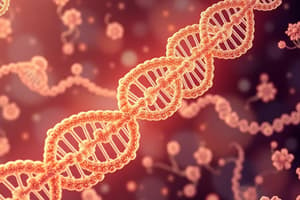Podcast
Questions and Answers
What is the role of aminoacyl-tRNA synthetases in protein synthesis?
What is the role of aminoacyl-tRNA synthetases in protein synthesis?
- To transcribe DNA into mRNA
- To regulate gene expression by binding to mRNA
- To ensure correct charging of tRNA molecules with amino acids (correct)
- To catalyze the formation of peptide bonds between amino acids
What is the primary function of messenger RNA (mRNA) in protein synthesis?
What is the primary function of messenger RNA (mRNA) in protein synthesis?
- To carry amino acids to the ribosome
- To carry the genetic information from DNA to the ribosomes (correct)
- To regulate gene expression by binding to other RNA molecules
- To form the structural and functional core of ribosomes
What is the role of ribosomal RNA (rRNA) in protein synthesis?
What is the role of ribosomal RNA (rRNA) in protein synthesis?
- To catalyze the formation of peptide bonds between amino acids (correct)
- To regulate gene expression by binding to mRNA
- To carry genetic information from DNA to the ribosomes
- To carry amino acids to the ribosome
What is the purpose of the methylated guanine cap added during RNA processing?
What is the purpose of the methylated guanine cap added during RNA processing?
Where does transcription take place in a cell?
Where does transcription take place in a cell?
Ribosomal RNA (rRNA) is directly involved in the formation of peptide bonds between amino acids to assemble a protein.
Ribosomal RNA (rRNA) is directly involved in the formation of peptide bonds between amino acids to assemble a protein.
Transfer RNA (tRNA) binds to mRNA through a sequence of codons that are complementary to the anticodon sequence in tRNA.
Transfer RNA (tRNA) binds to mRNA through a sequence of codons that are complementary to the anticodon sequence in tRNA.
MRNA carries the genetic information from ribosomes to DNA for the synthesis of proteins.
MRNA carries the genetic information from ribosomes to DNA for the synthesis of proteins.
Non-coding RNA molecules, such as microRNA and small interfering RNA, only regulate gene expression by promoting transcription through interactions with DNA.
Non-coding RNA molecules, such as microRNA and small interfering RNA, only regulate gene expression by promoting transcription through interactions with DNA.
During transcription, the inactive strand of DNA is used as the template for the synthesis of mRNA.
During transcription, the inactive strand of DNA is used as the template for the synthesis of mRNA.
Flashcards are hidden until you start studying
Study Notes
RNA Structure and Composition
- RNA is a single-stranded nucleic acid molecule composed of nucleotides, each consisting of a sugar molecule, a nitrogenous base, and a phosphate group.
- The nitrogenous bases in RNA are adenine (A), guanine (G), cytosine (C), and uracil (U).
- The sugar molecule in RNA is ribose, which has an additional hydroxyl group (-OH) compared to deoxyribose, the sugar found in DNA.
- The nucleotides in RNA are linked by phosphodiester bonds, which connect the 3′ carbon of one nucleotide to the 5′ carbon of the next nucleotide.
RNA Functions
- RNA plays a key role in protein synthesis, gene regulation, and information transfer.
- In protein synthesis, RNA serves as an intermediate between DNA and proteins.
- DNA contains the genetic information that encodes the sequence of amino acids in a protein, but it cannot directly interact with ribosomes. RNA can interact with ribosomes and carry the genetic code from DNA to the ribosomes, where proteins are synthesized.
RNA Types
- There are three main types of RNA: messenger RNA (mRNA), transfer RNA (tRNA), and ribosomal RNA (rRNA).
- mRNA carries the genetic information from DNA to the ribosomes, where it is translated into a sequence of amino acids to form a protein.
- tRNA plays a critical role in the translation process by carrying amino acids to the ribosome, where they are added to the growing protein chain.
- rRNA forms the structural and functional core of ribosomes, where it catalyzes the formation of peptide bonds between amino acids to assemble a protein.
Transcription
- Transcription takes place in the nucleus and is a biological process wherein a segment of the DNA is copied to mRNA.
- During transcription, a strand of mRNA is made that is complementary to a strand of DNA.
- The strand of DNA that is used to synthesize mRNA is known as the template strand or Active strand (3'-----5'). The other strand is called the non-template or inactive strand (5'-----3').
RNA Processing
- The transcribed RNA is known as the pre-mRNA and is processed further to convert it into mature RNA.
- RNA processing includes capping, polyadenylation, and splicing.
- Capping involves the addition of a methylated guanine cap to protect the mRNA.
Gene Regulation
- RNA also plays a crucial role in gene regulation.
- Various types of non-coding RNA molecules, such as microRNA (miRNA), small interfering RNA (siRNA), and long non-coding RNA (lncRNA), regulate gene expression by binding to mRNA and blocking translation, initiating degradation, or promoting transcription by interacting with DNA or other proteins in the gene regulatory network.
Studying That Suits You
Use AI to generate personalized quizzes and flashcards to suit your learning preferences.




